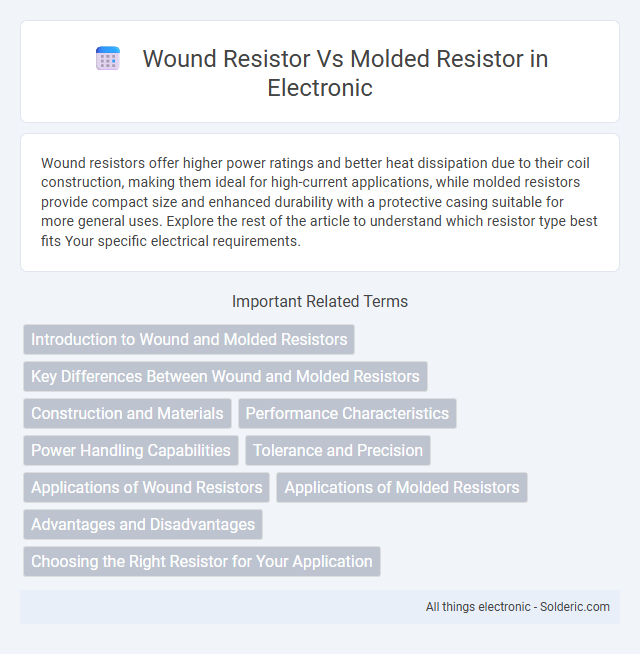Wound resistors offer higher power ratings and better heat dissipation due to their coil construction, making them ideal for high-current applications, while molded resistors provide compact size and enhanced durability with a protective casing suitable for more general uses. Explore the rest of the article to understand which resistor type best fits Your specific electrical requirements.
Comparison Table
| Feature | Wound Resistor | Molded Resistor |
|---|---|---|
| Construction | Wire coil wound around an insulating core | Resistive element embedded in molded epoxy or ceramic |
| Power Rating | High power dissipation (up to several watts or more) | Moderate power rating, generally less than wound resistors |
| Precision | High accuracy with low tolerance options | Moderate accuracy, wider tolerance range |
| Thermal Stability | Excellent thermal stability, suitable for high-temperature applications | Moderate thermal stability, limited high-temperature performance |
| Inductance | Higher inductance due to coil winding | Low inductance, ideal for high-frequency circuits |
| Size | Larger physical size | Compact and smaller size |
| Cost | Generally more expensive due to complex construction | Cost-effective for mass production |
| Applications | Power supplies, high-current circuits, load testing | Consumer electronics, general-purpose circuits |
Introduction to Wound and Molded Resistors
Wound resistors are precision components made by winding a resistive wire, typically nichrome, around an insulating core, offering superior power dissipation and stability under high temperatures. Molded resistors consist of a resistive material encased in a molded epoxy or ceramic compound, providing compact size and enhanced mechanical protection against environmental factors. Both types serve distinct applications where durability and electrical performance criteria vary based on resistance tolerance, power rating, and thermal endurance.
Key Differences Between Wound and Molded Resistors
Wound resistors feature wire coils tightly wound around a core, providing precise resistance and high power dissipation ideal for high-frequency applications. Molded resistors, typically composed of resistor elements embedded in a solid, molded compound, offer compact size and excellent mechanical stability suited for general-purpose use. Your choice depends on the power rating, tolerance, and environmental conditions required for optimal circuit performance.
Construction and Materials
Wound resistors feature a wire coil made of metal alloys like nickel-chromium wound around an insulating core, offering high power ratings and precise resistance values. Molded resistors consist of a resistive element embedded in a ceramic or epoxy molded casing, providing mechanical strength and protection against environmental factors. Your choice depends on the required durability and electrical performance, with wound resistors suited for high power and molded resistors ideal for compact, rugged applications.
Performance Characteristics
Wound resistors offer high precision and excellent power dissipation due to their construction using wire coils, making them ideal for applications requiring high stability and low noise. Molded resistors provide robust mechanical strength and better resistance to environmental factors like moisture and vibration, ensuring reliable performance in harsh conditions. Your choice depends on whether precise electrical characteristics or durable physical properties are more critical for your specific application.
Power Handling Capabilities
Wound resistors offer superior power handling capabilities compared to molded resistors, often rated from several watts up to hundreds of watts, making them suitable for high-power applications. Molded resistors typically handle lower power levels, generally under 5 watts, due to their compact construction and limited heat dissipation. The enhanced thermal management of wound resistors allows for consistent performance in demanding environments requiring robust power dissipation.
Tolerance and Precision
Wound resistors typically offer tighter tolerance levels, often ranging from +-0.1% to +-5%, making them ideal for precision applications requiring high accuracy. Molded resistors generally have wider tolerance values, commonly between +-5% and +-10%, which limits their use in circuits demanding exact resistance. The superior precision of wound resistors is attributed to their construction with tightly wound wire, ensuring consistent resistance and stability under varying conditions.
Applications of Wound Resistors
Wound resistors are primarily used in high-power applications requiring precise resistance and excellent heat dissipation, such as power supplies, motor control circuits, and audio equipment. Their robust construction allows them to handle high energy pulses and overloads, making them ideal for industrial machinery and lighting ballasts. If your project demands durability and accuracy in extreme conditions, wound resistors provide superior performance compared to molded resistors.
Applications of Molded Resistors
Molded resistors are widely used in applications requiring high reliability and stability under harsh conditions, such as automotive electronics, aerospace systems, and industrial machinery. Their encapsulated design protects against moisture, dust, and mechanical damage, making them ideal for high-vibration and high-temperature environments. These resistors are commonly found in power supplies, control circuits, and consumer electronics where consistent performance and durability are essential.
Advantages and Disadvantages
Wound resistors offer high power dissipation and superior inductance characteristics, making them suitable for high-frequency applications, but they tend to be bulkier and more expensive compared to molded resistors. Molded resistors provide compact size, low cost, and high reliability with stable resistance values, yet they generally have lower power ratings and less inductive properties than wound resistors. Choosing between wound and molded resistors depends on the specific electrical requirements, such as power handling, physical size constraints, and frequency response.
Choosing the Right Resistor for Your Application
Wound resistors offer high power ratings, excellent stability, and low noise, making them ideal for precision applications and high-power circuits. Molded resistors provide compact size, cost-effectiveness, and resistance to environmental factors, suitable for general-purpose electronics where space and durability are priorities. Your choice depends on specific requirements like power dissipation, tolerance, and environmental conditions to ensure optimal performance and reliability.
wound resistor vs molded resistor Infographic

 solderic.com
solderic.com